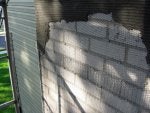I don't know if this is the right section, but plaster seems to be more like a masonry application than drywall.
I've been trying my hand at veneer plaster in the shop (USG Diamond basecoat and finish gypsum plaster) making a few mockups. I'm using CornerAid for the outside corners, but I'm have a real hard time getting straight outside corners and wondering if you have any tricks/techniques to share that might make it a bit easier.
Here's the mock up (I put a plaster bonding agent on before base coat)
![]()
I just did a base coat (brown coat ?), but I'm not happy with how it came out, so I'm thinking of maybe doing another basecoat to get the lines straightened out.
![]()
![]()
When I've done parging in the past, I've sometimes used the wet board technique against the corner, then run the trowel up to it, but it doesn't seem to work very well with the plaster.
I picked up an outside corner trowel, but it seemed to make the problem worse.
I've been trying my hand at veneer plaster in the shop (USG Diamond basecoat and finish gypsum plaster) making a few mockups. I'm using CornerAid for the outside corners, but I'm have a real hard time getting straight outside corners and wondering if you have any tricks/techniques to share that might make it a bit easier.
Here's the mock up (I put a plaster bonding agent on before base coat)

I just did a base coat (brown coat ?), but I'm not happy with how it came out, so I'm thinking of maybe doing another basecoat to get the lines straightened out.


When I've done parging in the past, I've sometimes used the wet board technique against the corner, then run the trowel up to it, but it doesn't seem to work very well with the plaster.
I picked up an outside corner trowel, but it seemed to make the problem worse.







